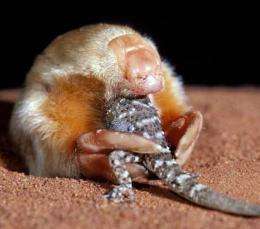Marsupial mole emerging from hole to eat a lizard. Photo copyright: Mike Gillam/Auscape
(PhysOrg.com) -- The mysterious origins of Australia's bizarre and secretive marsupial moles have been cast in a whole new and unexpected light with the first discovery in the fossil record of one of their ancestors.
The find reveals a remarkable journey through time, place and lifestyle: living marsupial moles are blind, earless and live underground in the deserts of the Northern Territory, Western Australia and South Australia, yet their ancestors lived in lush rainforest far away in north Queensland.
In the journal Proceedings of the Royal Society B, a team led by Professor Mike Archer, of the University of New South Wales (UNSW), reports the discovery of the remarkable 20 million-year-old fossil at the Riversleigh World Heritage fossil site.
Although related to kangaroos, koalas and other marsupials, living marsupial moles far more closely resemble Cape golden moles, which burrow through the desert sands of Africa. The two golden-furred animals not only look indistinguishable when seen side by side but share many other similarities in their teeth and skeletons that reflect their subterranean lifestyles.
Yet the Cape golden mole is a placental mammal - the group that includes rats, bats, elephants and humans – and these two very different branches of the mammal family evolved from a common ancestor at least 125 million years ago, says Professor Archer. Having diverged in ancestry, however, their similar lifestyles have meant that they have converged in anatomy.
"This fossil discovery came as a real shock," he says. "Until now, we had always assumed that marsupial moles must have evolved in an unknown ancient Australian desert because, like Cape golden moles, the living marsupial moles survive only in deserts.
"Yet this ancestral Australian mole, which is not as specialised as the living form, has been discovered in ancient rainforest deposits—not deserts. The fossils suggest that they became mole-like while burrowing through the mossy floors of those ancient forests."
This missing link has solved a second mystery about how the highly specialised V-shaped teeth of the living marsupial mole evolved. Although they are almost identical to the teeth of their African counterparts, it is now clear that they went down a completely different evolutionary pathway to get there, says co-author Dr Robin Beck of the American Museum of Natural History.
"This ancient link makes it clear that marsupials followed a completely different path from placentals but ended up with almost identical-looking teeth."
Co-author UNSW Associate Professor Suzanne Hand said: "It goes to the heart of global debates about relationship versus convergence - whether animals are similar because they are closely related or similar because they have had to adapt to related challenges. It's also exciting because it so beautifully demonstrates just how adaptive Australian marsupials can be when given the right evolutionary challenges and enough time to meet them."
Provided by University of New South Wales
























